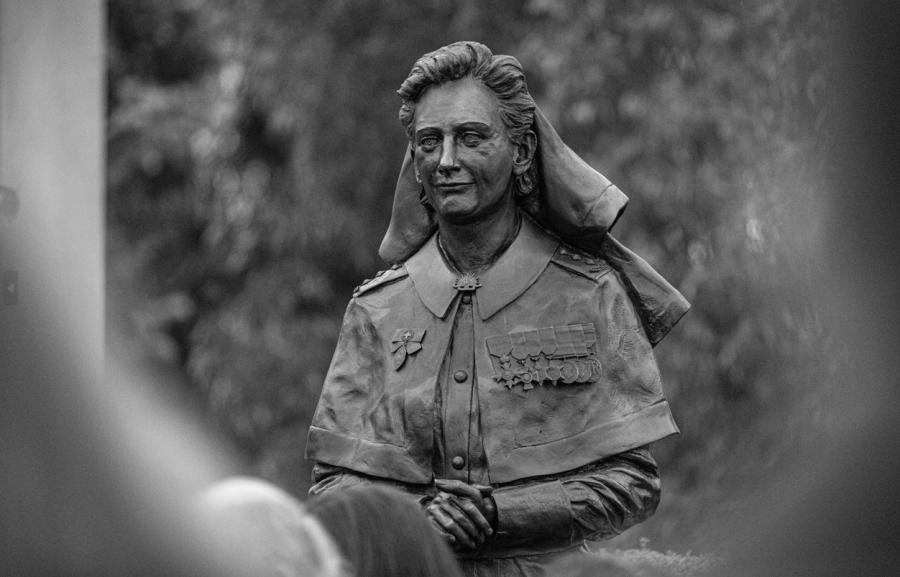'It's been an incredible honour'

It’s a nerve-racking moment for Dr Charles Robb.
The Brisbane-based artist has wrangled approximately 200 kilograms of clay to create a sculptural portrait of Second World War nurse Vivian Bullwinkel, and is watching as the final bronze sculpture is being craned into position at the Australian War Memorial in Canberra.
“It's been an incredible honour for me as an artist to work on a project like this,” Robb said.
“But when you see a work that you've spent many months working on suspended six metres in the air ... I think it would be inhuman if you didn't have a slight pang of anxiety.
“You can't help but worry about mishaps ... but we've got a fantastic team at the Memorial, who are absolute masters of how they handle sculptures, so I knew at all times I was in really safe hands.
“I've had the joy of spending the last few years working on the sculpture, but also researching into Vivian’s awe-inspiring life.
“The key thing that I wanted to achieve was to capture a likeness and a sense of the way she carried herself in the world. This quite strong and self-contained individual … while reflecting the perseverance that drove her.
“But the other dimension I was wanting to reflect in the work was this terrible moment in her life and in our nation's history ... the Banka Island massacre.”
Vivian Bullwinkel was one of 65 Australian nurses who escaped Singapore aboard the small coastal steamer Vyner Brooke, on 12 February 1942, just three days before the island fell to the Japanese.
When the Vyner Brooke was spotted and sunk by Japanese aircraft two days later, Bullwinkel drifted at sea for hours, clinging to a life raft, before struggling ashore on Banka Island along with other survivors.
After an unsuccessful attempt to gain food and assistance from local villagers, the group decided to surrender to the Japanese. The civilian women and children left in search of someone to whom they might surrender, as the nurses and soldiers waited with the wounded at Radji Beach.
But the Japanese patrol that arrived a few hours later did not take prisoners. They shot and bayoneted the men behind a rocky headland, then ordered the 22 Australian nurses, and a British civilian woman who had remained behind, to wade into the ocean. There the Japanese machine-gunned them from behind. Bullwinkel was wounded and was the only survivor.
She hid in the jungle for almost two weeks, caring for a wounded British soldier, Private Cecil Kingsley, before they gave themselves up. Kingsley died soon after and Bullwinkel was reunited with other survivors from the Vyner Brooke at a makeshift camp. She would spent the next three and a half years as a prisoner of war in and around Sumatra.
Of the 65 nurses evacuated from Singapore on the Vyner Brooke, only 24 survived the war.
Bullwinkel went on to testify at the war crimes tribunal in Tokyo and dedicated her life to ensuring that the nurses were never forgotten.
Today, her sculpture stands in the grounds of the Memorial opposite her friend, the wartime surgeon and fellow prisoner of war, Sir Edward ‘Weary’ Dunlop.
Commissioned in 2019 in partnership with the Australian College of Nursing Foundation, the sculpture is the first in the Memorial grounds to commemorate the service of an individual woman or nurse.
It includes 22 inlaid stainless steel discs reflecting the 22 victims of the Banka Island massacre. They are arranged at the base of the sculpture as a reflection of the stars that would have been visible in the night sky on 16 February 1942.
“It's quite remarkable,” Robb said as the sculpture was being installed.
“This is actually the first time I've seen Vivian and the base formally together, and hopefully bonded together for all time. It is lovely to see it finally, materially connected, after being separate things in the studio for so long.”
The sculpture took 40 weeks to produce and was created using a combination of digital and traditional sculptural processes.
“To make a work like this involved almost as many different sculptural processes as you can imagine,” Robb said.
“It's been 12 months in the studio, but it was another two years of concept design and development prior to that.
“But the guts of it is really working, and doing standard modelling, over an armature at scale, and then taking silicone moulds from that, which are then given to the foundry.”
The sculptural portrait of Bullwinkel stands three metres tall and was hand-modelled, using approximately 200 kilograms of clay. The oval base was digitally modelled, then milled in polystyrene using a robotic arm. The final form was further refined using paint and filler.
Both elements were cast using silicon bronze by craftsmen at Billman’s Foundry in Castlemaine, Victoria. The bronze surface was then polished, painted with a dark patina or colouring and waxed for shine and protection from the weather.
“It's quite a special thing to be involved in,” Robb said.
“I hadn’t heard of Vivian Bullwinkel before this project ... but, of course, through the project, I've discovered so much about this amazing woman in our history.
“I think that's quite surprising now ... and I'm kind of appalled that I didn't know about her, that I didn't learn about her in in high school. But what I love about a work like this, is that it draws people's attention to who this amazing woman was, what she achieved and why we should be remembering her.
“There’s a pang of sadness because the subject we're memorialising here is no longer with us.
“To see it come to completion and to see it finally on site is a really touching experience.”